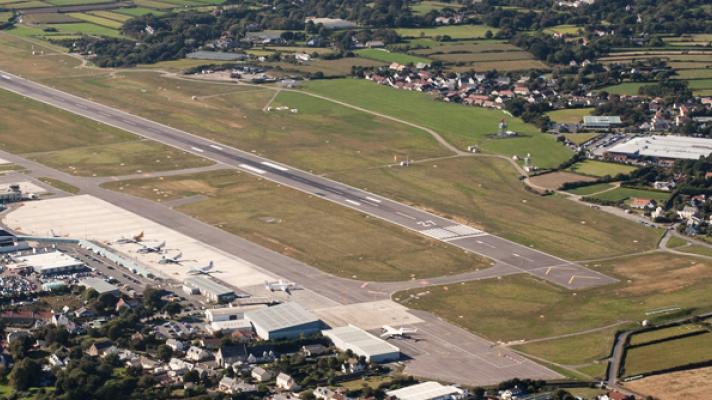A long-overdue report by PwC on the island’s runway options was finally released by our top Policy & Resources Committee (P&R) on March 8. It is most welcome for providing much needed underlying information and facts. But it puts States Deputies in an awkward spot.
The report is part of a much larger inquiry into air links and sea links, but the report on the latter has not yet been published and the former has effectively been hijacked by the runway lengthening issue. Indeed, this is only PwC’s ‘Part A’ on the subject. ‘Part B’, a study of the best runway options, is yet to begin because of a squabble over the overall project’s likely costs. P&R is reluctant to spend any money on a proper, professional business case of runway extension options. In some people’s view it is a disappointing example of a reluctance to invest adequate capital in infrastructure for the island’s future wellbeing.
Start with the Policy Letter, published by P&R to accompany the PwC report and due to be debated by the States assembly in April. It interprets the PwC findings as showing that Guernsey’s current connectivity and runway are satisfactory, that a small lengthening might be possible but anything outside the existing airport boundary would not necessarily attract larger aircraft or greater frequency. However:
- It rejects PwC’s professional advice that a proper business case evaluation of costs, benefits and risks should be carried out (as proposed for Part B) to arrive at a recommendation between the main feasible options (1463m no change, 1570m or 1700m variants). This raises questions whether government is making “evidence-based decisions”, as required for all major investments.
- It misleadingly claims (section 5.39) that “PwC recommends that the 1570m option appears to be the best runway option, if it is feasible from a commercial and operational perspective for more than one airline.” PwC do not “recommend” that option, for the obvious reason that they have yet to weigh up costs, benefits and risks against feasible alternatives. PwC actually recommends (page 22) that a further proper business case exercise is needed over a four-month period to arrive at a “recommendation.” PwC further recommends (page 20) that a 1700-1800m extension “should be taken forward as the primary alternative to the 1570m option”, adding: “There are clear additional benefits and it is lower risk in the longer term, although there may be a substantial cost difference.”
- It incorrectly suggests (section 5.28) that an 1800m option is required to attract low cost carriers such as EasyJet. Both EasyJet and BA operate out of Jersey’s 1706m runway.
- It suggests that the cost of evaluating the options could be “up to £700,000” and an inappropriate use of taxpayers’ money. This appears to be a surprisingly high (over?) estimate for evaluating two primary options beyond “do nothing.”
The Policy Letter also has some surprising omissions:
- No mention is made of a study in 2018 by the Chamber of Commerce and Institute of Directors business groups, which suggested potential benefits arising from a longer runway eventually approaching £100m per annum. This number looks optimistic, but it underscores the point that benefits should be a key element in any business case, and not be ignored merely for a short-term accounting desire to “spend the minimum.” Even £30m of benefit would help recoup the extension costs.
- No acknowledgement is made of recent detailed work carried out by experienced local architect and pilot Rob Le Page, which demonstrated that (i) the core 1700m runway could stay within the current airport perimeter (ii) a 90m stopway and EMAS runway-end safety area would take only 50% of the further area already safeguarded in the approved Island Development Plan for that purpose, and (iii) this would fill in the shallowest part of that area and no houses would need to be demolished.
Now look at the PwC Report attached to the P&R Policy Letter. It is illuminating.
- It debunks various misleading or incorrect assertions made in December when P&R first announced their decision not to fund PwC’s Part B report to evaluate options via a proper business case.
- It confirms that no option requires “half of St Peters village to be bulldozed,” as mooted by P&R at the time. Any extension would be in the opposite direction.
- It does not support the assertion that “only a 2000m runway would be a game-changer.” PwC actually rejects further consideration of a 2000m runway in their report. The real “game-changer” length is the 1700m option, which is comparable to Jersey and would allow both EasyJet and BA to operate here.
- It illustrates how state-owned Aurigny’s fares to Gatwick have risen in recent years relative to those from Jersey and, separately, quotes the loss-making airline’s chief executive as saying its business model would be “destroyed” if Easyjet had access to a longer runway.
- It contains no commercially sensitive information to justify the six-month delay in circulation to Deputies and the public. Perhaps Deputy Charles Parkinson was correct when, apparently knowledgeably, he speculated in a radio interview that the reason for the delay might be that the PwC Report did not support P&R’s stance announced in December.
What do these points suggest?
- Assertions that a runway extension is undeliverable politically, socially and environmentally seem wide of the mark if, for example, the 1700m option complies with the approved Island Development Plan and thus minimises any Planning Approval delays.
- The potential costs, benefits and risks associated with the main runway options look too important to be left to partially-informed hunches by a small group of politicians. Better, surely, to remain agnostic until the proper business case has been completed in an independent and professional manner.
- Deputies who are even less familiar with the detail must now consider not only dismissing the conclusions of the assembly’s top committee as premature and insufficiently evidence-based, but also funding PwC to evaluate the main options and arrive at an informed recommendation.
Quite why P&R has set its face against further work by PwC and put Deputies in such an awkward position remains a mystery. Perhaps a 1700m strip really is too hot a political issue. Perhaps the wider arguments about the island’s air links, by straying into questions about Aurigny, really do demand shared responsibility. Either way, because the issue stretches still further, to matters of infrastructure investment generally, it is crucial to the island’s longer-term economic future. And the longer it is left unresolved, the more it highlights the peculiar way we do things.







